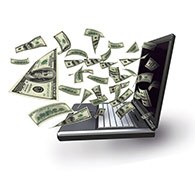НАВИГАЦИЯПОПУЛЯРНЫЕ СТАТЬИ
|
Russia`s GDP contracted by 7.9 percent last year in the sharpest decline in more than a decade as the country struggled under low energy prices and a flagging demand for its natural resources. Finance Ministry Alexei Kudrin said Tuesday that the government expects the GDP to rise by 4 percent compared to an earlier estimate of 3 percent. Many investment banks and financial institutions predict GDP growth as high as 5 percent. 20.04.2010 21:55 U. S. industrial production grew 0.1 percent in March 2010 U. S. industrial production inched higher last month as a cutback in utility use after an exceptionally cold February had the effect of dampening expansion, the Federal Reserve reported. Industrial output, measuring overall production at the nation`s factories, mines and utilities, rose 0.1% in March and extended the monthly string of increases to nine, but the increase wasn`t nearly as strong as expected. Economists surveyed by MarketWatch had forecast a 0.8% increase in industrial production. See MarketWatch calendar of major indicators. Production in February was revised higher by the Fed to an increase of 0.3%, up from the initial estimate of a 0.1% gain. Factory activity alone rebounded in March, recovering after having been held in check by snowstorms in the prior month. Factory production rose 0.9% in March, stepping up from a 0.2% gain in the prior month. The nation`s industrial sector has been enjoying a rapid recovery: Industrial production increased at a 7.8% annual rate in the first quarter, with the factory sector alone rising at a 6.6% rate. "Manufacturing is doing better than rest of the economy," wrote Ian Shepherdson, chief U. S. economist at High Frequency Economics. Utilities output dropped 6.4% in March as heating demand declined after February`s cold. Capacity utilization for total industry increased 0.2 of a percentage point to stand at 73.2% in March, the Fed`s data showed. This is the highest level since November 2008. In addition, capacity utilization is now 3.7 percentage points above the rate seen a year ago. Production of high-technology goods continued to expand at a solid pace, rising 1.9% in March after a 3.0% gain in the prior month. And motor-vehicle and auto-part production increased 2.2% last month, a reversal after having fallen 3.0% in February. 11.04.2010 13:19 China swings to $7.24 bln trade deficit in March 2010 that is the first in six years China reported a March trade deficit Saturday that was significantly wider than expected, as a surge in imports outpaced exports and commodities prices rose, according to media reports. March exports from China rose 24.3% to $112.11 billion, while imports jumped 66% to $119.35 billion, resulting in a $7.24 billion deficit, the state news agency Xinhua reported on its Web site. A poll of 13 economists conducted by Dow Jones Newswires had estimated a March trade deficit of $280 million. The monthly trade deficit marks China`s first in nearly six years; the country reported an April deficit in 2004. By comparison, China had a trade surplus of $14.2 billion in January of this year and of $7.6 billion in February, down from a high of $42.1 billion in January 2009. Many analysts see the deficit as temporary and anticipate China will swing back to a trade surplus in the coming months. 05.04.2010 23:06 Russian Inflation Slows to 12-Year-Low 6.5% as Ruble Gains Russia`s inflation rate fell to the lowest level in 12 years as a stronger ruble made imports cheaper and a sluggish recovery damps consumer demand, allowing the central bank to continue cutting rates. The rate dropped to an annual 6.5 percent last month from 7.2 percent in February, the Federal Statistics Service said in an e-mailed statement today. The median estimate in a Bloomberg survey of 15 economists was for the rate to decline to 6.6 percent. Prices advanced 0.6 percent from February. Bank Rossii has cut its benchmark refinancing rate 12 times in the last year to 8.25 percent to help the economy recover from its worst slump on record. Interest rates will fall further if the government meets its inflation target of between 6.5 percent and 7.5 percent for the year, Finance Minister Alexei Kudrin said in March. “A steady decline in inflation was one of Russia`s main economic achievements last year,” Alfa Bank economists led by Natalia Orlova in Moscow said in a research note on April 1. “By keeping real interest rates in positive territory, the Russian central bank is helping to generate retail deposit inflows to banks.” Even so, banks are unable to take advantage of slowing consumer-price growth as loan demand remains weak and companies struggle to pass on producer-cost increases, Alfa said. Price increases for services and non-food items led inflation last month, the statistics service said. 27.03.2010 12:35 U. S. GDP Revision Fail to Downplay Strength of Q4 Recovery The growth of U. S. GDP in the final quarter of 2009 was most significant in the last six years. According to verified data, U. S. GDP rose in fourth quarter to 5,6%. Initially, a month ago, reported the growth of the economy during the reporting period by 5,9%. Compared with the same period of 2008, GDP increased by 0,1%. For all the same in 2009 U. S. GDP declined by 2.4%. Compared with the originally published, the government revised downward investment in business structures, expenditure on services and investment in inventory. The downward revision to U. S. GDP is not good but at the same time it is important to realize that 5.6 percent GDP is still the strongest pace of growth reported since the third quarter of 2003, more than 6 years ago. It is also the fastest pace of fourth quarter GDP growth of all G7 nations which is not something to dismiss. In the fourth quarter, the U. S. economy grew at least 5 times faster than the Eurozone and U. K. A downward revision in personal consumption, weaker gross private investment and a larger than previously estimated decline in government consumption all contributed to the downward revision of GDP. 20.03.2010 13:41 Russian Industrial Production Grew 1.9% in February 2010 Russian industrial production expanded at a slower pace in February, led by manufacturers of steel pipes and rail freight containers, signaling the recovery of domestic demand hasn`t gained full steam. Output at factories, mines and utilities rose 1.9 percent after a 7.8 percent gain in January, the Federal Statistics Service in Moscow said. Non-seasonally adjusted output rose 4.8 percent from January, which began with a 10-day holiday. The median estimate of 12 economists in a Bloomberg survey was for annual and monthly increases of 6.6 percent. In January-February period Russian industrial production grew 5.8 percent from the year earlier. “Domestic demand is still suffering; it hasn`t fully recovered,” Tatiana Orlova, an economist at ING Bank NV in Moscow said by telephone today. “Among external factors, oil prices didn`t provide a big boost because they only shot up at the end of the month.” Urals oil, Russia`s chief export blend of crude, reached last month`s low of $68.66 on Feb. 8 before climbing back up to $75.26 a barrel at the end of the month. A government stimulus, companies` efforts to stabilize inventories and growing exports have prompted a recovery this year after industrial output contracted for 12 months in a row since October 2008. The economy shrank 7.9 percent last year, the worst slump since the collapse of the Soviet Union in 1991. 14.03.2010 17:28 Japan GDP growth revised down to 3.8 growth in the October-December quarter Japan GDP growth revised down to 3.8 growth. Japan`s economy grew slightly less than initially estimated in the October-December quarter, the government said, chiefly due to weaker capital investment. Gross domestic product (GDP) expanded at an annual 3.8 percent pace in the October-December quarter, a downgrade from the preliminary figure of 4.6 percent released last month, according to the Cabinet Office. On a quarterly basis, the world`s second-largest economy grew 0.9 percent in the three months ended December 31 from the July - September period, slower than the preliminary reading of a 1.1 percent growth. Capital investment, the amount companies spend on new assets, gained 0.9 percent from the previous quarter, down from an initial reading of 1 percent. Private inventory pushed down the GDP by 0.1 percentage point, instead of the first estimate of the positive contribution of 0.1 point. "Even though the growth rate is still positive, we still need to watch economic conditions closely," Chief Cabinet Secretary Hirofumi Hirano told a press conference, stressing that Japan`s economic condition remains severe. 06.03.2010 16:01 Russian economy grew 5.2 percent y/y in January 2010 In January 2010, the Russian economy grew 5.2% compared to January 2009, said Deputy Economic Development Minister Andrei Klepach. Compared to December 2009, GDP was up 0.3%. The GDP and economic growth is positive and supported by consumer demand, Klepach pointed out. “Investment demand and risks related to unemployment remain the weak links,” he added. According to the Ministry`s preliminary estimates, the Russian economy grew by over 3% in the fourth quarter of 2009. This year, it is expected to grow 3.1%. The Russian Federal Statistics Service said the country`s GDP dropped by 7.9% in 2009, the biggest decline in the last 15 years. In 2008, it was up 5.6%. Industrial output in Russia rose 7.8% in January from the same month the year earlier, the statistics office said on Feb. 15. However production fell a steep 20.4% in January from December, a plunge explained by the large number of holiday days in in January. Industrial production fell 10.8% for 2009 as a whole as Russia was hard hit by the economic crisis and only started to recover year-on-year from November. 23.02.2010 13:29 Japan Q4 2009 GDP grew 1.1 percent qtr/qtr and 4.6 percent annualised Japan`s economy grew 1.1 percent in October-December from the previous quarter, but policy-makers fear the recovery could lose momentum as the effect of stimulus fades. Spending by governments worldwide to fight the deepest recession in decades has continued to underpin growth in the world`s second-biggest economy and its peers in the West. The increase in Japan` gross domestic product (GDP) was bigger than a median market forecast of a 0.9 percent rise. That translated into an annualised increase of 4.6 percent, against a forecast of 3.7 percent growth. That followed a revised reading of zero growth in the July-September quarter. The U. S. economy grew at an annualised clip of 5.7 percent in the same quarter, while the euro zone economy expanded 0.1 percent on the quarter. Japan`s fourth quarter growth was led by exports and corporate investment, which picked up for the first time since January-March 2008. Economists polled by Reuters expect Japanese growth to slow to 0.2 percent in January-March and the following quarter. 14.02.2010 13:10 GDP increased by 0.1% in both the euro area and the EU27 during the fourth quarter of 2009 GDP increased by 0.1% in both the euro area (EA16) and the EU27 during the fourth quarter of 2009, compared with the previous quarter, according to flash estimates published by Eurostat, the statistical office of the European Union. In the third quarter of 2009, growth rates were +0.4% and +0.3% respectively. Compared with the same quarter of the previous year, seasonally adjusted GDP decreased by 2.1% in the euro area and by 2.3% in the EU27 in the fourth quarter of 2009, after -4.0% and -4.3% respectively in the previous quarter. During the fourth quarter of 2009, US GDP increased by 1.4% compared with the previous quarter, after +0.6% in the third quarter. US GDP rose by 0.1% compared with the same quarter of the previous year (-2.6% in the previous quarter). Over the whole year 2009, GDP fell by 4.0% in the euro area and by 4.1% in the EU27. In December 2009 compared with November 2009, seasonally adjusted industrial production fell by 1.7% in the euro area (EA16) and by 1.9% in the EU272. In November production grew by 1.4% and 0.9% respectively. In December 2009 compared with December 2008, industrial production declined by 5.0% in the euro area and by 4.9% in the EU27. Compared with 2008, the average production index for 2009 fell by 14.9% in the euro area and by 13.9% in the EU27. |
Цитата дняБольшинство людей начинают интересоваться акциями, когда все остальные интересуются. Время интересоваться — это когда никто другой не интересуется. Вы не можете купить что-либо популярное и выиграть от этого. |




 22.04.2010 21:00 Russia`s economy grew 0.6 percent in the first quarter this year Russia`s economic development minister said Wednesday that the country`s economy grew 0.6 percent in the first quarter this year, extending the recovery to three consecutive quarters. Elvira Nabiullina also said Russia`s GDP went up by 4.9 percent in March year-on-year, but warned that the recovery is still fragile. "Signs of recovery are evident, but it is still too early to talk about stability yet," she said in comments carried by Russian news agencies. Consumer demand and investment flows remain volatile, she said. Russia started to recover from the downturn last year, but industrial production and other statistics have sent mixed signals on how soon it will emerge from the slump. In his annual address to parliament, Prime Minister Vladimir Putin warned Tuesday that although Russia has emerged from recession, "it doesn`t mean that the crisis is over." He called for prudent budget spending and pledged to cut the budget deficit in half by 2012.
22.04.2010 21:00 Russia`s economy grew 0.6 percent in the first quarter this year Russia`s economic development minister said Wednesday that the country`s economy grew 0.6 percent in the first quarter this year, extending the recovery to three consecutive quarters. Elvira Nabiullina also said Russia`s GDP went up by 4.9 percent in March year-on-year, but warned that the recovery is still fragile. "Signs of recovery are evident, but it is still too early to talk about stability yet," she said in comments carried by Russian news agencies. Consumer demand and investment flows remain volatile, she said. Russia started to recover from the downturn last year, but industrial production and other statistics have sent mixed signals on how soon it will emerge from the slump. In his annual address to parliament, Prime Minister Vladimir Putin warned Tuesday that although Russia has emerged from recession, "it doesn`t mean that the crisis is over." He called for prudent budget spending and pledged to cut the budget deficit in half by 2012. Автор:
Автор: 
 Комментарии: 0
Комментарии: 0 Просмотров: 26
Просмотров: 26


